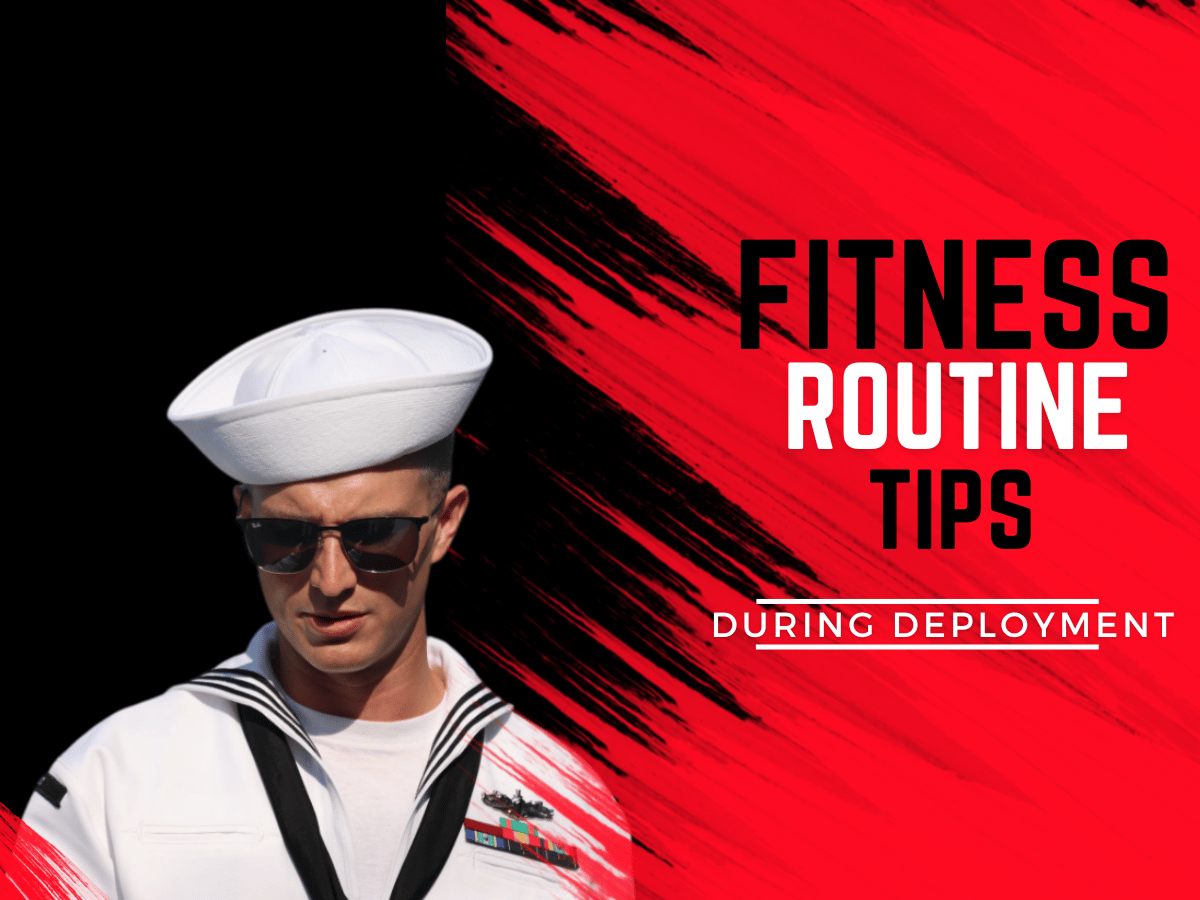
Cody Dodd is a NASM-certified personal trainer and Navy Command Fitness Leader who uses his fitness expertise to write fitness content for The DoddFather. Cody has transformed his physique and confidence by understanding the principles of exercise and fitness.
It all started with a radical fat loss of 55 pounds. From 225 to 170. From a kid who once couldn’t do a pull up, to knocking out 20 pullups in a Navy command competition while floating in the middle of the ocean.
He has a diverse writing and editing background that’s primarily focused on health and fitness, Navy life, and dad life. His work has been featured in Good Dads, as well as Platform Launchers, and Daddying.
Have you ever felt like your fitness goals get completely derailed the moment you’re deployed? Trust me, I’ve been there. It’s tough to stay motivated when your gym is a cleaning gear locker and your weights are sandbags.
But here’s the thing: staying fit during deployment isn’t just about looking good. It’s about feeling strong, boosting your energy, and keeping your mind sharp for the mission. A good fitness routine during deployment can be the difference between feeling sluggish and stressed or feeling unstoppable and focused.
Imagine crushing your workouts even with limited equipment, feeling confident in your body, and having the mental toughness to tackle any challenge that comes your way. That’s what’s possible when you commit to a fitness routine, even when you’re far from home.
In this post, I’m sharing my tried-and-true tips for creating a killer fitness routine during deployment. I used these ideas on my deployments to Greece, Spain, South Africa, Panama, Ecuador, Curacao, and Puerto Rico. Whether you’re a seasoned gym rat or a workout newbie, I’ve got you covered with easy-to-follow advice and workout ideas. Get ready to transform your body and mind, one rep at a time!
Editorial Note: We earn a commission from partner links on The DoddFather. Commissions do not affect our editors’ opinions or evaluations. Learn more about our Editorial Process.
Key Highlights
- Keeping fit while deployed is key for your mental health, team spirit, and action readiness.
- With deployment come hurdles like not having much to work with, schedules that change constantly, dealing with the weather and where you are, not having enough room, and few choices for healthy eating.
- Even though it’s tough to stay active during deployment because of these obstacles, doing so can help a lot. It keeps you physically prepared, prevents injuries, helps control weight, ensures better sleep, stops diseases, builds mental toughness, strengthens teamwork, sharpens focus, and provides a break from stress.
- To ensure you stay moving when resources are scarce on deployment – Embrace changes, use exercises that only require your body weight, aim to get stronger each time, pay attention to keeping your core stable, try resistance training using whatever gear you’ve got around, create workouts that move quickly from one exercise to another, adjust cardio workouts for small spaces, think outside the box with military gear, and find ways to work out together.
- With limited options, staying on top of nutrition and taking time to recover properly supports maintaining fitness gains made during deployment. Fueling up right under challenging conditions is important, too.
Building Unbreakable Resilience: Fitness Routine During Deployment
For service members on deployment, staying in top shape is key to being prepared for whatever comes their way. The regular Military PT that they’re used to might have slowed down a lot. Keeping up with physical fitness means doing workouts that boost endurance, build strength, and improve overall health. Let’s talk strategies and ideas surrounding a good fitness routine during deployment.

Embracing Adaptability
When you are deployed, you might not find the fancy gyms and workout places you’re used to back home. But it’s crucial to adjust and use whatever equipment is around. With things like resistance bands, suspension trainers, or even makeshift items like backpacks filled with sand or bags of sand, there are many options for keeping up with physical activity and staying in shape. The main thing is being flexible enough to keep moving and maintain fitness levels during deployment.
The Power of Bodyweight Workouts
When you’re out on deployment, sticking to a workout routine can be tough. But here’s the thing: bodyweight exercises are perfect because you don’t need any gear, and you can do them just about anywhere. They help you use your weight to get stronger and boost your fitness level all around. Let me walk you through some go-to moves that should be a staple in your plan:
- With push-ups, you work on not just your chest but also your shoulders and triceps. Changing up how fast you do them or where your hands are placed keeps things interesting.
- Starting with planks is great for making sure your core is as solid as a rock. Begin by holding it for short periods and then slowly add more seconds as it gets easier.
- Lunges are all about beefing up those legs—think quads, hamstrings, and glutes especially. For variety, you could mix in some walking lunges or even step back into reverse ones. I do NOT recommend this one for ship life.
- If pull-ups are what you’re after but finding a bar seems impossible, no sweat! Look around for a strong tree branch or grab onto something like a suspension trainer; they’re awesome for building strength in the upper body, including back muscles, biceps, and shoulders.
- Squats shouldn’t be skipped either since they target pretty much the same lower-body areas as lunges but from different angles, which is cool if pistol squats or adding jumps sounds fun.
The key idea? Blend these exercises together, focusing on getting stronger (strength) and keeping going without tiring too quickly (endurance). Kick off at an easy pace by doing only so many reps that feel okay, then notch it up bit by bit over time while always watching out that form stays spot-on, avoiding injuries altogether.
Combatting the Waves
The coolest thing about exercising underway is the added resistance and muscular balance. You’re working against the waves. If you can bench press the loaded barbell with the ship rocking, imagine how much easier that weight will be on solid ground.

It’s key to pick exercises that help you face all sorts of challenges head-on and make you stronger each time you do them. Here are some tips:
- With Progressive Overload, aim to slowly up the ante by increasing how heavy your weights are or making your exercises harder over time. This way, your muscles always have a new challenge.
- By doing Circuit Training, mix different exercises back-to-back with little breaks in between. It’s great for not just getting stronger but also boosting stamina and heart health.
- High-Intensity Interval Training (HIIT) is about going hard for a short while then resting briefly before going hard again. It’s super efficient for gaining strength quickly, plus it helps with endurance and melting calories.
- For endurance-focused workouts, try adding activities like long runs or weight-carrying over distances into your routine to improve your staying power and overall fitness levels.
- Mixing up Repetition Schemes can really test your muscles. For example, you can use lighter weights but do more reps for lasting muscle power or opt for heavier weights but fewer reps when aiming for peak strength.
Adding these methods to your fitness routine during deployment will help you tackle any obstacle more effectively while building up resilience and physical toughness every step of the way.
Core Stability
Keeping your core strong is important for staying balanced and strong, especially in situations where things can change fast, like during deployment(find your sea legs!). Working on your core muscles helps keep you stable and lowers the chance of getting hurt. Here are some good exercises to make sure your core stays solid:
- Plank variations: To work different parts of your core, try doing planks other than the regular one, side planks, moving from one plank position to another (plank rotations), and lifting a leg while in a plank pose.
- Russian twists: Sit down with knees bent and feet off the ground. Grab something heavy or a medicine ball and twist back and forth; this will work those side muscles.
- Bridge exercises: Lay on your back with your knees up and feet flat. Pushing through your heels, lift up those hips which fires up both glutes (your butt)and that all-important midsection.
- Dead bugs: Start by lying flat with legs in the air bent at 90 degrees—like how dead bugs look—and then stretching out opposite arm-and-leg pairs.
Adding these moves to your regular routine will help boost stability around the middle part of your body and balance overall, as well as muscle strength near the spine area—all super useful for being more durable during times like deployment involving lots of physical activity or changes in environment.
Utilizing Improvised Gear
When you’re deployed, finding regular gym equipment might be tough. But, you can still get a good resistance workout by using things around you. Here’s how to make the most of your workouts without standard gear:
- With backpacks or sandbags: You can fill these with heavy stuff for added weight during squats, lunges, and overhead presses.
- Resistance bands are easy to carry and great for many exercises that work out various muscles.
- Through bodyweight exercises: Moves like push-ups, pull-ups, and dips use your weight for resistance and can be tweaked to focus on certain muscles more.
- Picking up improvised weights: Look for items such as rocks, logs, or ammo boxes that could serve as makeshift weights in exercises like deadlifts, rows, and shoulder presses.
By getting creative with what’s available during deployment, you’ll keep building strength through practical resistance training.
Completely unique poems catered to the different dad types. Each poem neatly formatted on a beautiful card that you can print at home!

Maximizing Fitness Gains with Limited Resources
When you’re out on deployment, it might feel like you don’t have much to work with for staying fit. However, that doesn’t mean your fitness has to take a back seat. By being creative and flexible, you can keep in shape and even get stronger despite the limitations. Let’s discuss how you can make the most of what you’ve got to boost your fitness.
Circuit Training For Efficient Workouts in Confined Spaces
Circuit training is a super effective way to get the most out of your workout, especially when you don’t have much room. It’s all about doing different exercises back-to-back with little to no breaks in between. This way, you work out various parts of your body, boost your heart health, and increase both strength and endurance. If you’re looking to set up a good circuit training routine while on deployment or in any small space, here are some pointers:
- Start by picking exercises that hit different muscle groups so that you can enjoy a well-rounded session.
- For each exercise, either do it for a certain time frame or complete a specific number of reps before jumping into the next one.
- Try not to rest too much between moves; this keeps your heart rate up and ensures you get those cardio benefits.
- Get creative with your exercises—consider using your bodyweight, resistance bands, or whatever gear you have handy.
Adding circuit training to how often or hard you work out helps you really make good use of limited space and pushes you towards reaching peak fitness levels even when options seem narrow.
Interval Runs: Adapting Cardio Sessions to Limited Space
Keeping your heart healthy and building stamina is key, even if you’re tight on space and can’t run miles. You can still get a great cardio workout in by tweaking how you do your exercises. Interval running is perfect for this because it pumps up the benefits for your heart without needing much room. Here’s what to do:
- Look around for a space where you have enough room to move – like a hallway, an outdoor track, or just some open area on a ship.
- Use a timer and plan out bursts of fast running followed by periods where you slow down or stop to rest. A good pattern might be 30 seconds going all out, then 30 seconds taking it easy.
- Give it everything you’ve got during those fast bits, then take the slower times to breathe and prepare for the next round.
- Keep repeating these intervals until you reach the best number of rounds or time limit.
Using interval runs tailored to whatever space is available during deployment will help keep fit and improve endurance levels significantly while burning off calories efficiently.
Creative Use of Gear: Turning Military Equipment into Workout Tools
Being in the military gives you access to gear that can double as workout equipment. Think outside the box and use what’s around you to stay fit. Here are some ideas:
- With ammo cans, try doing squats, lunges, or push them up over your head.
- For sandbags, pack them with sand or something heavy and do deadlifts, carry them around, or press them overhead.
- Gas cans can be handy weights for moves like thrusters (a kind of squat-push press combo) or carrying them on each side as you walk (farmer’s walks).
- If you’ve got a paracord or any strong rope, it’s great for climbing exercises or pulling sleds.
- Tires aren’t just lying around; they’re perfect for flipping over, dragging behind you, or stepping onto.
By getting creative with everyday military items during deployment, you add resistance training into your routine and keep workouts interesting.

Partner Exercises: Leveraging Teamwork for Enhanced Fitness
When you’re out on deployment, working together as a team is key. It’s not just about getting the job done; it can also make staying fit more enjoyable and effective. Doing exercises with a partner isn’t only fun but helps strengthen your connection with your teammates while giving both of you a solid workout. Here are some duo workouts to try:
- For partner push-ups, one person does push-ups while the other adds resistance or support by pressing down lightly on their upper back or feet.
- Assisted squats involve holding onto each other for balance and support as you squat down and stand up again.
- With wheelbarrow walks, one holds the ankles of the other, who then walks forward on their hands. This works out your core stability and builds upper body strength.
- Lastly, standing face-to-face and tossing a medicine ball to each other engages those core muscles and strengthens your upper body.
Incorporating these kinds of exercises into what you do when deployed can spice up how you stay in shape. They help improve how well everyone works together, boost coordination skills, keep motivation high during tough times away from home, and provide that much-needed moral support we all appreciate when pushing through challenging tasks.
Nutrition and Recovery: Supporting Your Fitness Journey on Deployment
When you’re on deployment, taking care of your body by eating right and getting enough rest is key to staying fit. By giving your body the nutrients it needs and making sure you have plenty of time to recover, you’ll be able to perform better physically and lower your chances of getting hurt. Here are a few tips on how to manage nutrition and recovery while deployed:
Nutritional Strategies

When you’re out on deployment, getting the right nutrition might be tough, but it’s definitely doable. Here are a few tips to keep in mind:
- Go for whole foods first: Try to eat foods that are packed with nutrients like lean meats, fruits, veggies, and grains that haven’t been messed with too much.
- Drink plenty of water: It’s super important to drink enough water every day, especially when it’s really hot or the weather is extreme.
- Think ahead about your meals: Plan what you will eat and prepare some meals or snacks before time. Think tuna packs, protein bars, protein powder. This way, you’ll always have good food choices close by.
- Be smart about supplements: If you think your diet is missing something important, things like protein shakes, vitamins, or greens can help fill those gaps.
- Watch how much you eat: Pay attention to how big your servings are. When there aren’t many options available for eating well-balanced meals, focus more on quality rather than quantity.
By following these steps for better nutrition during deployment periods, you can make sure your body gets what it needs even when conditions get tough.
Recovery Techniques
When deployed, service members must focus on recovery techniques to ensure their muscles repair and grow properly. Getting enough sleep, eating right, & staying hydrated are the basics. On top of that, doing stretches, mobility workouts, and using a foam roller can really help with getting better faster.
Making recovery a priority during physical training while away from home base ensures that deployed personnel keep performing at their best no matter what challenges come up. This way, they stay fit and mission-ready all the time.
Hydration Tips
For service members heading into deployment, drinking enough water is key to performing at their best. Monitoring how much you drink and your body’s electrolyte balance is vital if you want to stay energized and think clearly. Making sure you’re well-hydrated is a must to avoid getting tired and keep both your mind and body sharp.

Using drinks with lots of electrolytes or apps designed to track how much water you drink can be a big help. Drinking plenty of fluids doesn’t just help with physical endurance; it also plays a huge role in staying healthy during challenging times. Consider investing in one of those water bottles that are so large they look like a fire hydrant.
Completely unique poems catered to the different dad types. Each poem neatly formatted on a beautiful card that you can print at home!

Psychological Resilience: Mental Health Strategies for Deployed Personnel
Keeping your mind strong is super important for people working far from home. When you’re deployed, dealing with being away and all the unexpected stuff can really mess with your head. Here’s how to keep yourself feeling good mentally and stay tough in the face of challenges:
- For starters, try ways to chill out, such as taking deep breaths, meditating, or staying present. These methods can help calm you down and clear your head.
- Next, aim for meaningful goals and celebrate the little wins along the way. Breaking big tasks into smaller bits keeps you going and makes you feel proud when you finish them.
- Remember to surround yourself with a group of people who lift you up. Being around positive people gives you a boost and helps you get through tough spots more easily.
By doing these things, anyone working away from home can better look after their mental health and become stronger at handling whatever deployment throws at them.
Conclusion
To wrap things up these thoughts on a good fitness routine during deployment – resilience isn’t just about how strong you are physically. It’s also about being flexible, creative, and rigid in the mind. When facing challenges, go for workouts that make the most of what you’ve got and look after your overall health. Mix it up with clever exercises, smart eating habits focused on nutrition, and taking care of your mental health to stay strong during deployment.
Your journey in staying fit shows off your incredible spirit. Keep pushing yourself every day with lots of motivation and focus; conquer each challenge as it comes. Remember, true strength is not only in how much you can lift but also in never giving up, no matter what life throws at you.
Frequently Asked Questions
What If I Can’t Follow My Normal Fitness Routine While Deployed?
When you’re away and can’t stick to your usual workout plan, adjusting and going with the flow is vital. With challenges popping up, look for different workouts or things to do that suit where you are right now. By keeping a positive mindset, concentrate on staying fit and healthy overall.
How Can I Stay Motivated to Exercise During Deployment?
Maintaining the motivation to work out while deployed can be tough, but it’s super important for your body and mind. Make sure to set goals that you can actually reach, pick activities that make you happy, and stick with a workout routine. Exercise is such an awesome method to shake off stress and lift your spirits during deployment, so it really is a great way to look after your mental health.
Are There Specific Exercises That Are More Beneficial During Deployment?
During deployment, all kinds of physical activity are good for you. However, some exercises might be better suited depending on what your deployment requires. For instance, endurance activities like running or swimming greatly boost heart health. On the other hand, lifting weights or doing strength training can keep your muscles strong or even make them stronger.
How Do I Adjust My Fitness Goals When Faced with Limited Resources?
When you’re out there on deployment and find yourself short on gear, it might be time to rethink your fitness targets. With just a little bit of space, calisthenics and bodyweight exercises can become your best friends since they don’t need much stuff. Try shifting gears towards keeping up with general fitness levels by tweaking what you aim for based on what’s around you and the situation at hand.




